Archive for the ‘STORYSPACE’ Category
STORYSPACE & HYPERTEXT: Changes
In trying to focus a visual paper (Keynote) on the single topic of changes that both writer and writing undergo in the transition to hypertext form, I’ve gotten down to fifty pages of posts from this weblog that made me smile or appeared relevant. From those fifty pages I’ve copied into ten pages certain phrases and sometimes whole posts to melt down into clarification when the fat rises to the top and can be skimmed off.
From there, I’ve copied certain of the best (either because they make good points or because I can’t get over my own eloquence sometimes) and have granted them a slide in the show. Mostly these are taken in time sequence, but I’m trying to keep them in the flow of certain issues I want to cover in the presentation.
Likely will finish up the rough first draft of the Keynote slide show today or tomorrow, putting everything in place and then figuring what can be removed or compressed. I think that the idea of a slideshow, for me, is an accompaniment to a talk, and whether I read off the slide and add a bit to it, or use it just as an outline, it needs to be organized and timed.
Also, it needs to be self-contained. If I faint dead away then someone will be able to click through it and frankly, the audience would probably prefer it that way.
HYPERTEXT ’08 Hullabaloo
I’m up to about 27 slides in Keynote so far, mostly images of Storyspace maps, some text boxes, a couple Hyptertextopia slides, and a lot of either quotes from Hypercompendia postings on working with hypertext or some targeted slides with the whole bulleted thing; these latter two are really to mark my place in speaking and jog my memory as to what I am speaking about.
There are a lot of slides to add in yet–but there are many that can be taken out. I started with the visuals because they show the work in progress and yes, because they’re pretty. If I’m a complete failure as a speaker (that’s why I’m a writer, duh!) then at least there’ll be something nice to look at on the screen. As a last resort, I’ll do my Buster Brown ad. Poll Parrot too, if there’s time. And even Robert Hall for Tunxis’ sake.
Actually I’m very excited about this–scared out of my wits, but excited. There are some pretty solid hot shots in the hypertext field to stand alongside here, as well as another concurrently running workshop with which to share the available audience.
Please, come early to the Pittsburgh conference and come to our workshop; it’ll be exciting and fun!
STORYSPACE: Planning
As I’ve mentioned before, I don’t go about writing story with a plot in mind. The only time I’ve done that was when I wrote a novel ten years ago and believe me, though I’m down to just a copy on the hard drive and one hardcopy (lotsa good scrap paper here), I’m to the point of really being willing to delete it forever from existence.
Storyspace does allow for a super duper plotting system, what with it’s views of Tree, Map, Chart, and Outline. It does not, however, encourage one such as I to conform to a layout that requires preplanning of narrative.
I like that. A lot.
What Storyspace does encourage is a form of going with the flow, allowing the paths to wander yet be connected by threads, titles, and color coding. I am directionally dysfunctional in my real life and that, complete to the point of fear of getting lost, was the biggest stumbling block in reading hypertext for me. With Storyspace, particularly in Map View, I don’t get that ‘lost’ feeling; I feel like a god overlooking the planet. And, I can drill down into the minutest writing space in an hierarchy to still make a guy trip over a curb and spill his coffee.
Fun stuff.
HYPERTEXT & STORYSPACE: Acknowledging the Learning
What’s so great about going through six months’ worth of postings on a particular topic is that it is much like getting together with a pal and reliving some great times you’ve spent together.
In reading through on my work with Storyspace and Hypertextopia that produced some of my best writing to-date, I’m enjoying the adventure of it all but validating my opinion that the hypertext format is something that–like the structure of poetry–has had a distinct influence on my writing style.
In returning to linear narrative for a creative writing course, I find that phrases come more easily, stories invent themselves, characters do whatever the hell they want to do and I can’t stop them because…because the paths of hypertext allowed them their reasoning behind their motives. The visual text box imposes a limit of sorts on how much should be told. Yes, those boxes stretch to any length and width, but the environment seeks some form of organization and even the simple matter of keeping the boxes similar in size makes a point. For example, a well-filled writing space usually indicates an action or vital informational segment of story. A few sentences–or just a single one–makes not only a dramatic point that lets the sentence stand out by itself, the visual of it floating alone like an old bullfrog on a lily pad gives it its deep bellowing impact.
We often don’t know how we progress as writers; it is a gradual thing that someone else may comment upon that makes us look back and discover the footprints in the trail. Well, as I look back, I see some mother tracks in the dirt just behind me.
HYPERTEXT: May I present…
I guess there’s no reason to keep it a secret–I’ll be presenting at a workshop on June 19th in Pittsburgh, PA at the Hypertext 08 conference. That’s what all this “presentation” talk is about. That’s my opening slide above.
What I’m doing now to get started is putting together an outline that I should be able to easily follow to show the path of a writer’s first exploration of hypertext as a creative writing medium. I’m filtering through the posts here since they are sort of a blow-by-blow daily report of the journey.
I’m learning Mac Keynote as the slide program–since if there’s something else for an audience to look at besides me, I won’t be as nervous. It will also keep me on course since I tend to ramble off in other directions–the typical hypertext mind, now given status raised from scatterbrained to the methodical mapping of the hypertext way of thinking.
I’m loving working with Keynote, and I’m loving the creative side of presenting a presentation. What I am also finding is that the images I’m using of my work in Storyspace show colorful maps that fairly light up the slide screen since part of my strategy in narrative structure was to separate the perspectives/characters/outcomes by color coding. That way–though I didn’t–I could have set the text boxes up in patterns following the linking of the threads and not lose track of the individual threads themselves.
So in and among the typical bulleted text slides that are more for my own notes than for audience reading, there will be some lovely full color shots of hypertext maps and spaces. I’m psyched!
STORYSPACE: Paths Downloads (Update #5)
This is a download point for a story I’ve written using the Storyspace hypertext software and may be read by doing the following:
Download and unzip both the .ssp file which is the piece, and the Storyspace Reader.app file which allows you to view the story. In the case of Windows, there will be an additional small .sni file that includes settings. Once downloaded, open the Storyspace Reader and maneuver to the file called Paths.ssp to open the project.
For Mac: Paths (Draft 3)
For Windows: Paths (Draft 2)
If you have any problems–or critique, for that matter–please let me know!
Enjoy!
STORYSPACE: A Journey
Have you ever gone back and read something you’ve written a while ago and you find yourself surprised by your own words?
In preparing a presentation on a writer’s experience with hypertext, I’ve been going back through the posts in the Storyspace category here. I’m copying & pasting the portions of the posts into a Pages program to sort of give myself a timeline of events in learning the hypertext environment as well as highlighting the major points in writing into it. Then I’ll edit, edit, edit, leaving just some form of outline upon which to base my talk. But oh, how I wish I could just print out the posts into a book format and hand it out; I’d almost forgotten how exciting a trip it was!
But I did find a gem of an opening line (and as we all know, if I have my opening line then I usually can run from there) and this may even be duplicated in slide show format in case I get too nervous to do more than mumble. It’s the very first post I wrote on beginning the Storyspace project, and it foretells exactly what was to come, and what I had oddly enough planned as my topic of this talk:
Opening Post, originally on Spinning, 10/27/07:
STORYSPACE: Something New
Got it. Downloaded and registered and ready to go. I check out the manual and am almost intimidated: 317 pages. I don’t like anything that takes 317 pages to learn.
But I’d already played in this and now I’m ready. The manual’s just a look-see. There in case I need it while the story’s getting laid.
I am not me and nothing I have written to this time will ever be the same. It brings out poetics. It brings ideas. It is a map that’s ready to be designed into a story.
STORYSPACE: Compartments of the Mind
I know I’ve said it here before; hypertext appears to me to resemble the cognitive process. The chain of events that are sparked by a word is a recall of experience based on memories–allowing for perception–and often wanders off the trail to be so far removed from "three links back" that we find ourselves within a familiar but seemingly unrelated space.
In attempting to comprehend the effect of Alzheimers from the inside workings of such a mind afflicted, I wonder if we can see a pattern, trace a word-to-word progression of a thought.
Fascinating. Terrifying too.
STORYSPACE: A Bottle of Beer – Format
Done primarily as backup, a version of A Bottle of Beer has been put into Storyspace for safekeeping. I do have a word document on it as well, as Jeremy at Hypertextopia has made it easy to grab off the internet.
The primary difference is that the “Shards” need to be linked back to the “Fragment” from which they are text-linked since they open up as a separate window in Storyspace, rather than as a text window alongside the main window as in Hyptextopia. There is a possibility of doing this in SSP. but that would mean that all text windows would need to be kept open.
I was able to follow the color coding of the different threads of disconnected shards (themes) that I’ve used in BoB, as shown on the map above and on the text window below, which includes several text links:
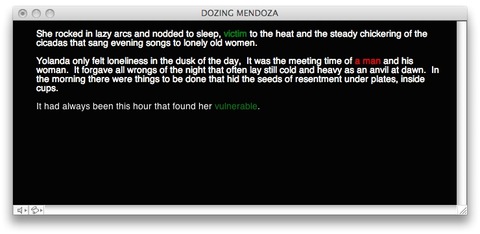
The ‘shard’ windows have colored text to match the theme, as was done in Hypertextopia, though I may need to make the typeface larger to show up more clearly:

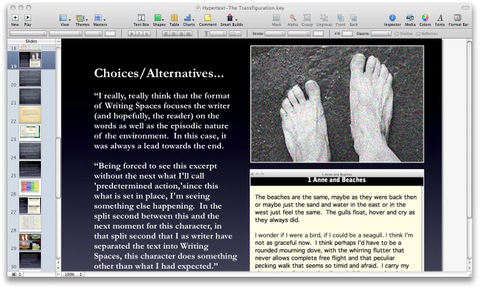
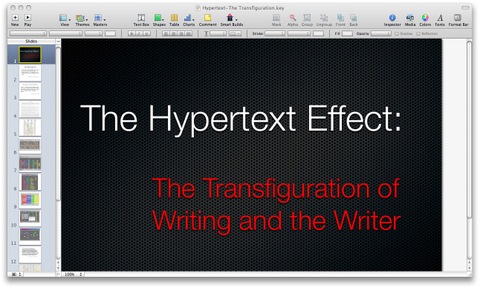
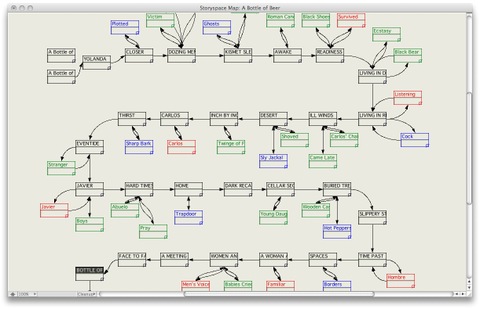
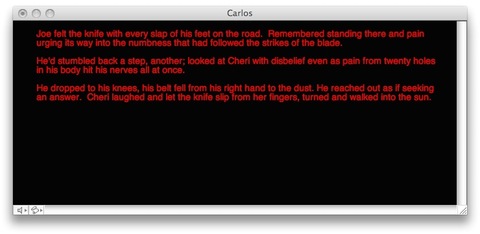
 The Lost Children: A Charity Anthology
The Lost Children: A Charity Anthology